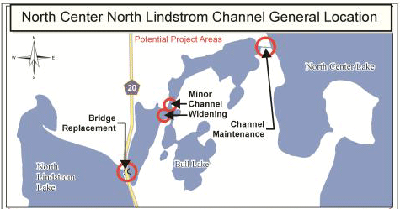February 6, 2019 at 12:52 p.m.
The annual meeting for the Chisago Lakes Lake Improvement District basically featured updates on activities that the LID is involved in which are on-going, with nothing drastically new on this week’s yearly meeting agenda.
There are plans being laid to eradicate the invasive weed, phragmites, and improvements to navigation between North Center and North Lindstrom Lakes are being reviewed, but these are in-development. Being not ready for primetime, there was little citizen input on these issues. A lakeshore property owner stated he opposes anything being done with the channel that could affect lake levels, and was assured no LID project will impact water depth of either North Center or North Lindstrom lakes.
Mike Mergens, who serves as LID chair, told the audience that there will be a cost-benefit analysis done of channelizing costs-- to make sure it is a justifiable expense.
He said the channel bottom elevation is being regulated and needs to be preserved, plus there are many permits to apply for and regulations to meet, saying, “We need a design and plan yet.”
He added that Blue Waters Leisure Park, a mobile home and seasonal campground community that abuts the channel, “is not willing” to work with the LID on the project; so widening of channel access will need to come from easements acquired to the south side of the site, where the water flow connects into North Center Lake. The property owners here are cooperating, Mergens added.
Depending on what’s ahead, however, “This could all become cost prohibitive,” he stated.
It was announced that a subcommittee is working on the phragmites problem.
It will draft an outline of what the LID might contribute towards eliminating this non-native water plant/ reed. At this time, efforts at eliminating large accessible stands of the invasive plant have been happening through lake associations.
LID Board elections were open for an at-large and the Area 1 seats.
Mergens and incumbent Gary Schumacher won their seats back. There were 56 absentee votes plus 33 ballots used at the annual meeting.
Casey Thiel, with Chisago County Soil & Water Conservation District, explained some of the continuing water quality projects the SWCD and its partner government units are undertaking. She said the county LID and SCWD have been very successful in leveraging four to five times funding, by being pro-active on projects, doing research and data collection to substantiate grant-funded projects.
Street sweeping is an effective water quality protection measure, and Thiel has been teaming with Lindstrom and Chisago City on schedules and locations, to target municipal sweeping runs for the biggest impact.
SWCD staff work closely with agricultural agencies too-- on projects like water sediment control basins in rural areas. Thiel said 20 of these are installed on farmsteads in the LID watershed annually on average.
Thiel said residential property owners can also ask about the cost-share program which helps water quality. Berms, hillside stabilization and shoreline restorations at private homesites are all potential candidates for this 50-50 cost share program (provides up to $1,500 as one half.)
Jerry Spetzman, water resources administrator for Chisago County, reported the aquatic invasive species inspection program had 13,579 contacts last summer, at 24 water access points. The Comfort Lake-Forest Lake Watershed District is sharing in costs for this program. Inspectors look for boat drain plugs’ removal and bait and livewell water contents not being drained, along with weeds on the boat and trailer and other obvious aquatic “hitchhikers” that should not be carried from water body to water body.





Comments:
Commenting has been disabled for this item.